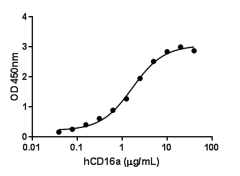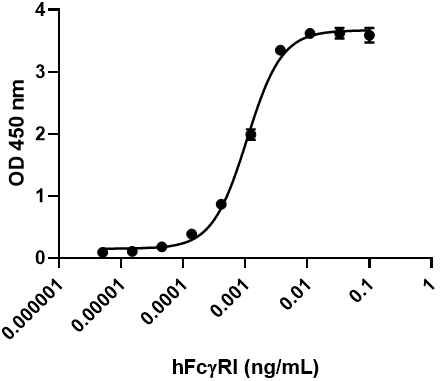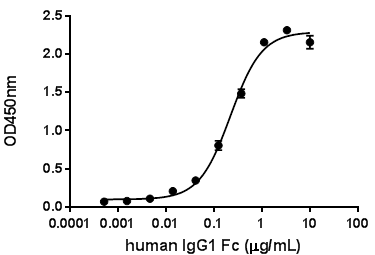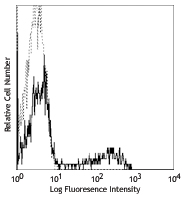- Regulatory Status
- RUO
- Other Names
- Low affinity immunoglobulin gamma Fc region receptor III-A, CD16a antigen, CD16a, Fc-gamma RIII-alpha, Fc-gamma RIII, Fc-gamma RIIIa, FcRIII, FcRIIIa, FcR-10, IgG Fc receptor III-2, FCGR3, FCGR3A, IGFR3
- Ave. Rating
- Submit a Review
- Product Citations
- publications

-

When human IgG1 (Cat. No. 403501) is immobilized at 1 µg/mL, human FcγRIIIA/CD16a binds with ED50 of 0.6 - 2.4 µg/mL in a functional ELISA. -

Stability testing for Human FcγRIIIA/CD16a. Human FcγRIIIA/CD16a was aliquoted in PBS, pH 7.2 at 0.2 mg/ml. One aliquot was freeze and thawed four times (4x freeze/thaws), and compared to a control kept at 4°C (control). The samples were tested in a binding assay with human IgG1.
Fcγ RIII, also known as CD16, is a low affinity IgG Fc receptor for a broad range of different isotypes. It primarily exists as two distinct forms: Fcγ RIIIA/ CD16a and Fcγ RIIIB/ CD16b, which are encoded by two nearly identical genes in humans. The expression of the two isoforms is tissue-specific. Fcγ RIIIA is a 50-65 kD type I transmembrane protein that is expressed on the surface of NK cells, activated monocytes, macrophages, and placental trophoblasts in humans. FcγRIIIB is a 48 kD GPI-anchored protein. Its extracellular domain is over 95% homologous to that of Fcγ RIIIA, and it is expressed specifically on neutrophils. Fcγ RIIIA can bind aggregated IgG or IgG-antigen complex which functions in NK cell activation, phagocytosis, and antibody-dependent cell-mediated cytotoxicity (ADCC). Several studies indicated that the post-translational modifications of Fcγ RIIIA or IgG regulate Fcγ RIIIA-mediated functions. The glycosylation of Fcγ RIIIA is mandatory for high affinity binding to Fc. Additionally, lack of fucosylation of Fc glycans dramatically enhance ADCC by improving the binding of Fcγ RIIIA and IgG. Is has been reported that the polymorphism (F176V) showed a greater binding capacity to IgG, leading to increasing antibody-dependent NK cell cytotoxicity and susceptibility to autoimmune diseases. The missense mutation (L66H) causes immunodeficiency 20 disease (IMD20). Fcγ RIIIA associates with γ and zeta chains of T-cell antigen receptor complex (CD3:TCR) and FcεRIγ on human NK cells, suggesting involvement of distinct signal-transducing function.
Product DetailsProduct Details
- Source
- Human FcγRIIIA/CD16a, amino acid (Gly17-Gln208) (Accession # AAH17865.1), with a C-terminal 6His tag, was expressed in 293E cells.
- Molecular Mass
- The 198 amino acid recombinant protein has a predicted molecular mass of approximately 22.6 kD. The DTT-reduced and non-reduced protein migrates at approximately 50 kD by SDS-PAGE. The predicted N-terminal amino acid is Gly.
- Purity
- > 95%, as determined by Coomassie stained SDS-PAGE
- Formulation
- 0.22 µm filtered protein solution is in PBS, pH 7.2.
- Endotoxin Level
- Less than 0.1 EU per µg protein as determined by the LAL method.
- Concentration
- 10 and 25 µg sizes are bottled at 200 µg/mL. 100 µg size and larger sizes are lot-specific and bottled at the concentration indicated on the vial. To obtain lot-specific concentration and expiration, please enter the lot number in our Certificate of Analysis online tool.
- Storage & Handling
- Unopened vial can be stored between 2°C and 8°C for up to 2 weeks, at -20°C for up to six months, or at -70°C or colder until the expiration date. For maximum results, quick spin vial prior to opening. The protein can be aliquoted and stored at -20°C or colder. Stock solutions can also be prepared at 50 - 100 µg/mL in appropriate sterile buffer, carrier protein such as 0.2 - 1% BSA or HSA can be added when preparing the stock solution. Aliquots can be stored between 2°C and 8°C for up to one week and stored at -20°C or colder for up to 3 months. Avoid repeated freeze/thaw cycles.
- Activity
- When human IgG1 (Cat. No. 403501) is immobilized at 1 µg/mL, human FcγRIIIA/CD16a binds with ED50 of 0.6 - 2.4 µg/ml in a functional ELISA.
- Application
-
Bioassay
- Application Notes
-
BioLegend carrier-free recombinant proteins provided in liquid format are shipped on blue ice. Our comparison testing data indicates that when handled and stored as recommended, the liquid format has equal or better stability and shelf-life compared to commercially available lyophilized proteins after reconstitution. Our liquid proteins are verified in-house to maintain activity after shipping on blue ice and are backed by our 100% satisfaction guarantee. If you have any concerns, contact us at tech@biolegend.com.
Antigen Details
- Structure
- Ig family molecule
- Distribution
-
NK cells, activated monocytes, macrophages, neutrophils, subpopulation of T cells, immature thymocytes; plasma membrane, secreted
- Function
- Low affinity IgG Fc receptor, phagocytosis, ADCC
- Ligand/Receptor
- Aggregated IgG, IgG-antigen complex
- Bioactivity
- Measured by its ability to bind human IgG1
- Biology Area
- Immunology, Innate Immunity
- Molecular Family
- CD Molecules, Fc Receptors, Soluble Receptors
- Antigen References
-
- de Vries E, et al. 1996. Blood 88: 3022.
- Jawahar S, et al. 1996. Clin. Exp. Immunol. 103:408.
- Dall'Ozzo S, et al. 2004. Cancer Res. 64: 4664.
- Ravetch JV, Perussia B. 1989. J. Exp. Med. 170: 481.
- Wu J, et al. 1997. J. Clin. Invest. 100:1059.
- Mizushima T, et al. 2011. Genes Cells 16:1071.
- Anderson P, et al. 1990. Proc. Natl. Acad. Sci. USA. 87: 2274.
- Jawahar S, et al. 1996. Clin. Exp. Immunol. 103:408.
- Ferrara C, et al. 2006. J. Biol. Chem. 281:5032.
- Ferrara C, et al. 2011. Proc. Natl. Acad. Sci. USA. 108:12669.
- Ravetch JV, Kinet JP. 1991. Annu. Rev. Immunol. 9:457.
- Vivier E, et al. 1992. Int. J. Cancer Suppl. 7:11.
- Altin JG, et al. 1994. Immunol. Cell. Biol. 72:87.
- Gene ID
- 2214 View all products for this Gene ID
- UniProt
- View information about CD16a on UniProt.org
Related Pages & Pathways
Pages
Related FAQs
- Why choose BioLegend recombinant proteins?
-
• Each lot of product is quality-tested for bioactivity as indicated on the data sheet.
• Greater than 95% Purity or higher, tested on every lot of product.
• 100% Satisfaction Guarantee for quality performance, stability, and consistency.
• Ready-to-use liquid format saves time and reduces challenges associated with reconstitution.
• Bulk and customization available. Contact us.
• Learn more about our Recombinant Proteins. - How does the activity of your recombinant proteins compare to competitors?
-
We quality control each and every lot of recombinant protein. Not only do we check its bioactivity, but we also compare it against other commercially available recombinant proteins. We make sure each recombinant protein’s activity is at least as good as or better than the competition’s. In order to provide you with the best possible product, we ensure that our testing process is rigorous and thorough. If you’re curious and eager to make the switch to BioLegend recombinants, contact your sales representative today!
- What is the specific activity or ED50 of my recombinant protein?
-
The specific activity range of the protein is indicated on the product datasheets. Because the exact activity values on a per unit basis can largely fluctuate depending on a number of factors, including the nature of the assay, cell density, age of cells/passage number, culture media used, and end user technique, the specific activity is best defined as a range and we guarantee the specific activity of all our lots will be within the range indicated on the datasheet. Please note this only applies to recombinants labeled for use in bioassays. ELISA standard recombinant proteins are not recommended for bioassay usage as they are not tested for these applications.
- Have your recombinants been tested for stability?
-
Our testing shows that the recombinant proteins are able to withstand room temperature for a week without losing activity. In addition the recombinant proteins were also found to withstand four cycles of freeze and thaw without losing activity.
- Does specific activity of a recombinant protein vary between lots?
-
Specific activity will vary for each lot and for the type of experiment that is done to validate it, but all passed lots will have activity within the established ED50 range for the product and we guarantee that our products will have lot-to-lot consistency. Please conduct an experiment-specific validation to find the optimal ED50 for your system.
- How do you convert activity as an ED50 in ng/ml to a specific activity in Units/mg?
-
Use formula Specific activity (Units/mg) = 10^6/ ED50 (ng/mL)

 Login / Register
Login / Register 












Follow Us